Caltex Australia Limited: Financial Risk Management Strategies Report
VerifiedAdded on 2023/01/23
|11
|2895
|57
Report
AI Summary
This report provides a comprehensive analysis of the financial risks faced by Caltex Australia Limited, a prominent company in the refining and petroleum manufacturing sector. It delves into the company's exposure to foreign exchange risk, commodity price risk, and customer credit risk, highlighting the potential impact of these risks on its operations and financial performance. The report examines Caltex's risk management approach, including its framework for identifying, evaluating, and addressing risks, as well as its hedging strategies to mitigate the impact of currency fluctuations and commodity price volatility. It details the types of hedging instruments employed by the company, such as swaps, options, and forwards, and how these instruments are utilized to manage cash flow and fair value exposures. Furthermore, the report provides insights into the company's credit risk management policies and its efforts to minimize the impact of customer credit risk. Overall, the report offers a detailed overview of Caltex Australia Limited's financial risk profile and its proactive approach to managing these risks.
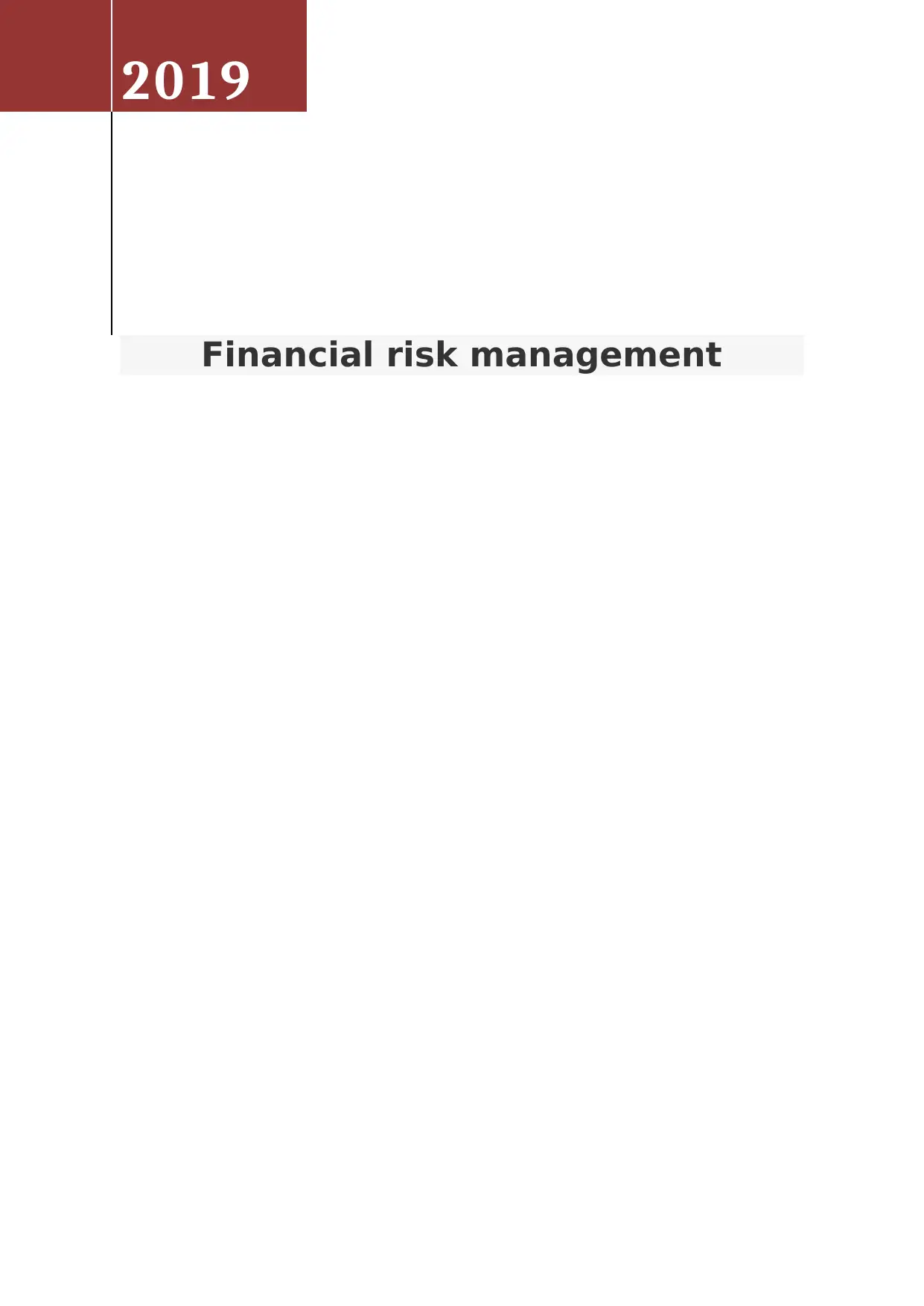
Financial risk management
2019
2019
Paraphrase This Document
Need a fresh take? Get an instant paraphrase of this document with our AI Paraphraser

Caltex Australia Limited
Executive Summary
A company cannot perform without expanding and with the expansion comes the concept of
risk. To ensure growth and a higher level of return it is imperative that the company will face
risks of various kinds. In this report, the emphasis is on the Caltex Australia Limited which
happens to be listed on the Australian Stock exchange. The company is a pioneer in the field
of refining and petroleum manufacturing. The following report projects the performance of
the group together with the financial risks that it faces. The report highlights the relevant risks
and the risks management procedure of the company. The second part of the report deals in
hedging technique of the company and the instruments utilized by it.
2
Executive Summary
A company cannot perform without expanding and with the expansion comes the concept of
risk. To ensure growth and a higher level of return it is imperative that the company will face
risks of various kinds. In this report, the emphasis is on the Caltex Australia Limited which
happens to be listed on the Australian Stock exchange. The company is a pioneer in the field
of refining and petroleum manufacturing. The following report projects the performance of
the group together with the financial risks that it faces. The report highlights the relevant risks
and the risks management procedure of the company. The second part of the report deals in
hedging technique of the company and the instruments utilized by it.
2
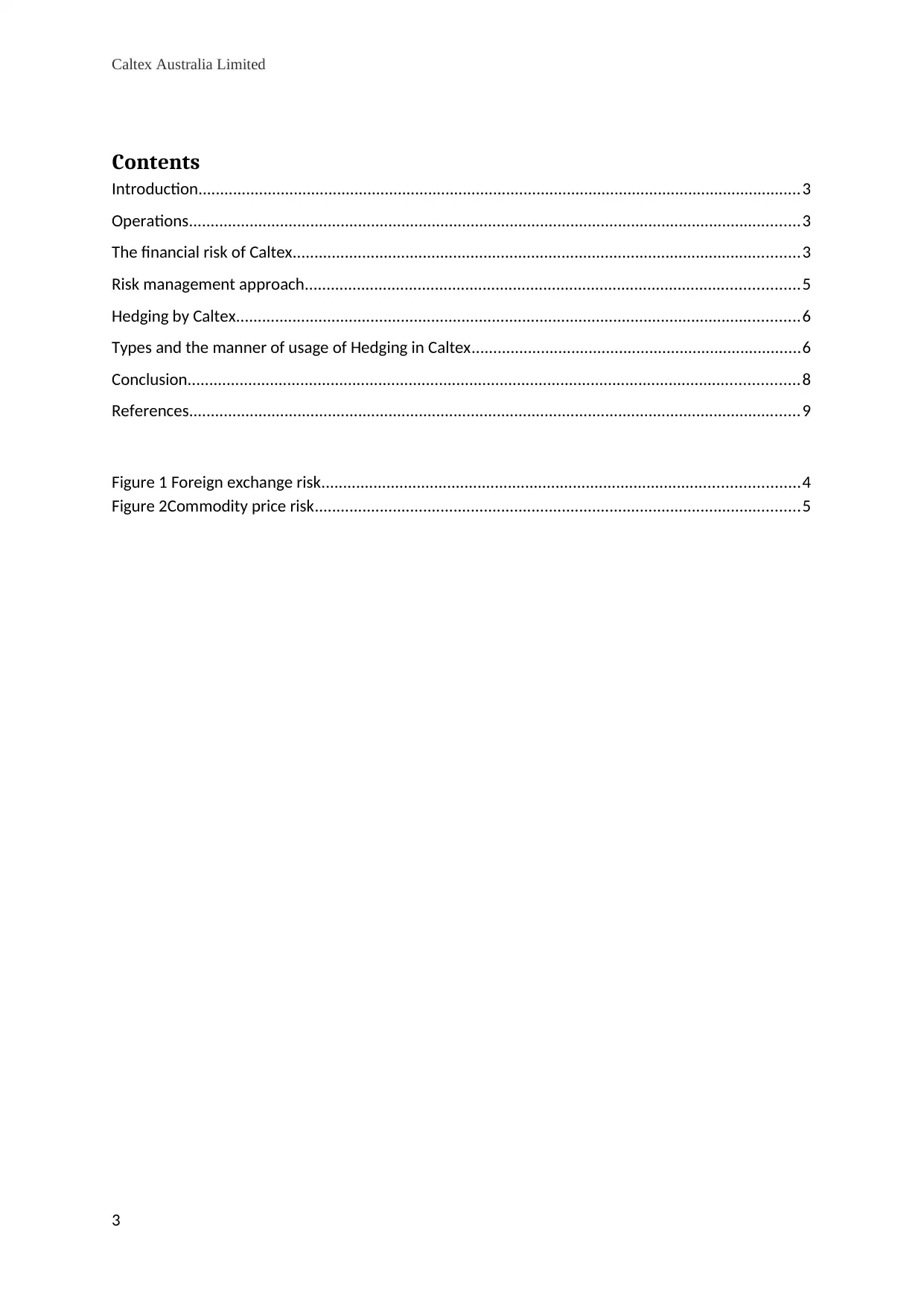
Caltex Australia Limited
Contents
Introduction...........................................................................................................................................3
Operations.............................................................................................................................................3
The financial risk of Caltex.....................................................................................................................3
Risk management approach..................................................................................................................5
Hedging by Caltex..................................................................................................................................6
Types and the manner of usage of Hedging in Caltex............................................................................6
Conclusion.............................................................................................................................................8
References.............................................................................................................................................9
Figure 1 Foreign exchange risk..............................................................................................................4
Figure 2Commodity price risk................................................................................................................5
3
Contents
Introduction...........................................................................................................................................3
Operations.............................................................................................................................................3
The financial risk of Caltex.....................................................................................................................3
Risk management approach..................................................................................................................5
Hedging by Caltex..................................................................................................................................6
Types and the manner of usage of Hedging in Caltex............................................................................6
Conclusion.............................................................................................................................................8
References.............................................................................................................................................9
Figure 1 Foreign exchange risk..............................................................................................................4
Figure 2Commodity price risk................................................................................................................5
3
⊘ This is a preview!⊘
Do you want full access?
Subscribe today to unlock all pages.

Trusted by 1+ million students worldwide
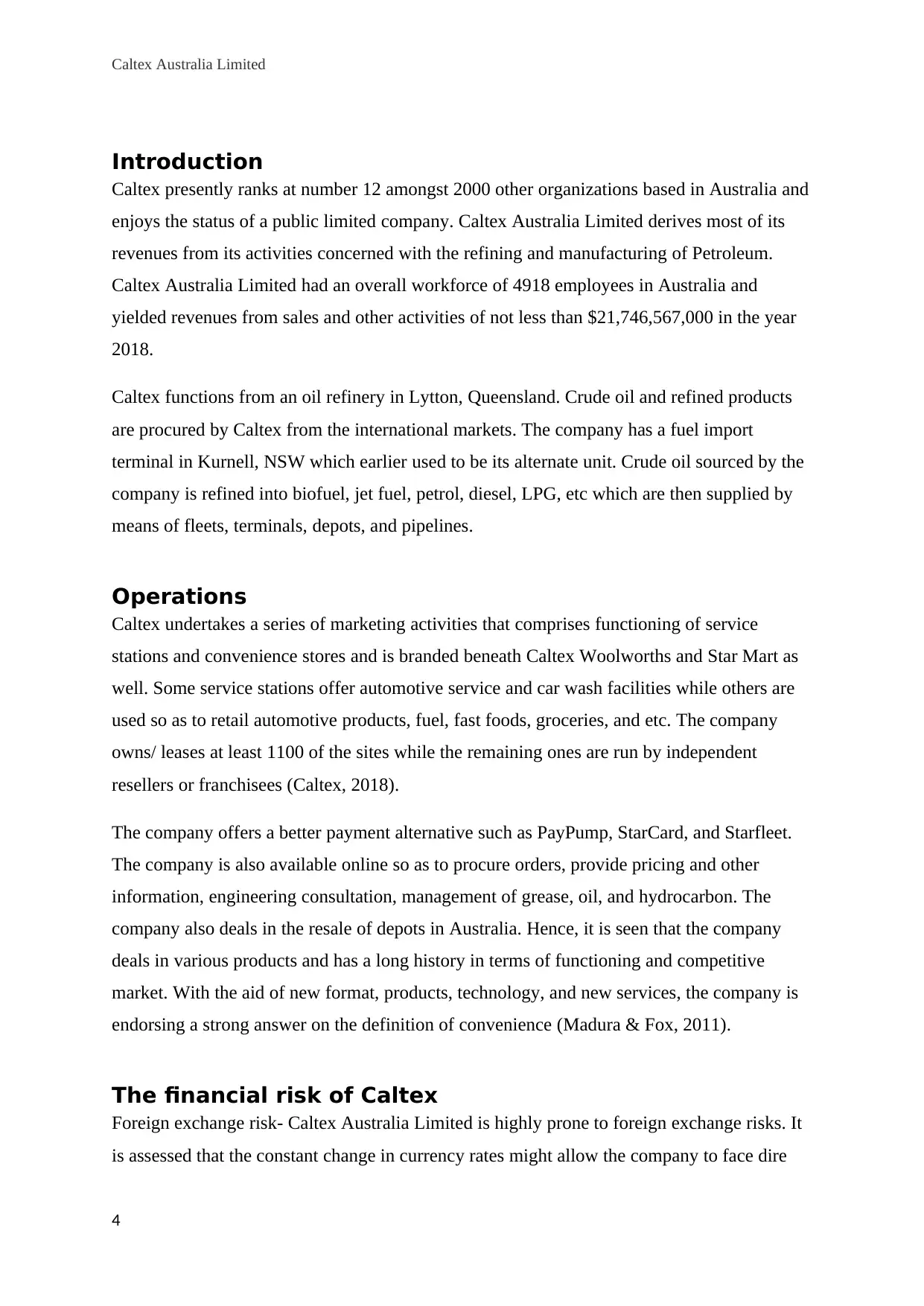
Caltex Australia Limited
Introduction
Caltex presently ranks at number 12 amongst 2000 other organizations based in Australia and
enjoys the status of a public limited company. Caltex Australia Limited derives most of its
revenues from its activities concerned with the refining and manufacturing of Petroleum.
Caltex Australia Limited had an overall workforce of 4918 employees in Australia and
yielded revenues from sales and other activities of not less than $21,746,567,000 in the year
2018.
Caltex functions from an oil refinery in Lytton, Queensland. Crude oil and refined products
are procured by Caltex from the international markets. The company has a fuel import
terminal in Kurnell, NSW which earlier used to be its alternate unit. Crude oil sourced by the
company is refined into biofuel, jet fuel, petrol, diesel, LPG, etc which are then supplied by
means of fleets, terminals, depots, and pipelines.
Operations
Caltex undertakes a series of marketing activities that comprises functioning of service
stations and convenience stores and is branded beneath Caltex Woolworths and Star Mart as
well. Some service stations offer automotive service and car wash facilities while others are
used so as to retail automotive products, fuel, fast foods, groceries, and etc. The company
owns/ leases at least 1100 of the sites while the remaining ones are run by independent
resellers or franchisees (Caltex, 2018).
The company offers a better payment alternative such as PayPump, StarCard, and Starfleet.
The company is also available online so as to procure orders, provide pricing and other
information, engineering consultation, management of grease, oil, and hydrocarbon. The
company also deals in the resale of depots in Australia. Hence, it is seen that the company
deals in various products and has a long history in terms of functioning and competitive
market. With the aid of new format, products, technology, and new services, the company is
endorsing a strong answer on the definition of convenience (Madura & Fox, 2011).
The financial risk of Caltex
Foreign exchange risk- Caltex Australia Limited is highly prone to foreign exchange risks. It
is assessed that the constant change in currency rates might allow the company to face dire
4
Introduction
Caltex presently ranks at number 12 amongst 2000 other organizations based in Australia and
enjoys the status of a public limited company. Caltex Australia Limited derives most of its
revenues from its activities concerned with the refining and manufacturing of Petroleum.
Caltex Australia Limited had an overall workforce of 4918 employees in Australia and
yielded revenues from sales and other activities of not less than $21,746,567,000 in the year
2018.
Caltex functions from an oil refinery in Lytton, Queensland. Crude oil and refined products
are procured by Caltex from the international markets. The company has a fuel import
terminal in Kurnell, NSW which earlier used to be its alternate unit. Crude oil sourced by the
company is refined into biofuel, jet fuel, petrol, diesel, LPG, etc which are then supplied by
means of fleets, terminals, depots, and pipelines.
Operations
Caltex undertakes a series of marketing activities that comprises functioning of service
stations and convenience stores and is branded beneath Caltex Woolworths and Star Mart as
well. Some service stations offer automotive service and car wash facilities while others are
used so as to retail automotive products, fuel, fast foods, groceries, and etc. The company
owns/ leases at least 1100 of the sites while the remaining ones are run by independent
resellers or franchisees (Caltex, 2018).
The company offers a better payment alternative such as PayPump, StarCard, and Starfleet.
The company is also available online so as to procure orders, provide pricing and other
information, engineering consultation, management of grease, oil, and hydrocarbon. The
company also deals in the resale of depots in Australia. Hence, it is seen that the company
deals in various products and has a long history in terms of functioning and competitive
market. With the aid of new format, products, technology, and new services, the company is
endorsing a strong answer on the definition of convenience (Madura & Fox, 2011).
The financial risk of Caltex
Foreign exchange risk- Caltex Australia Limited is highly prone to foreign exchange risks. It
is assessed that the constant change in currency rates might allow the company to face dire
4
Paraphrase This Document
Need a fresh take? Get an instant paraphrase of this document with our AI Paraphraser
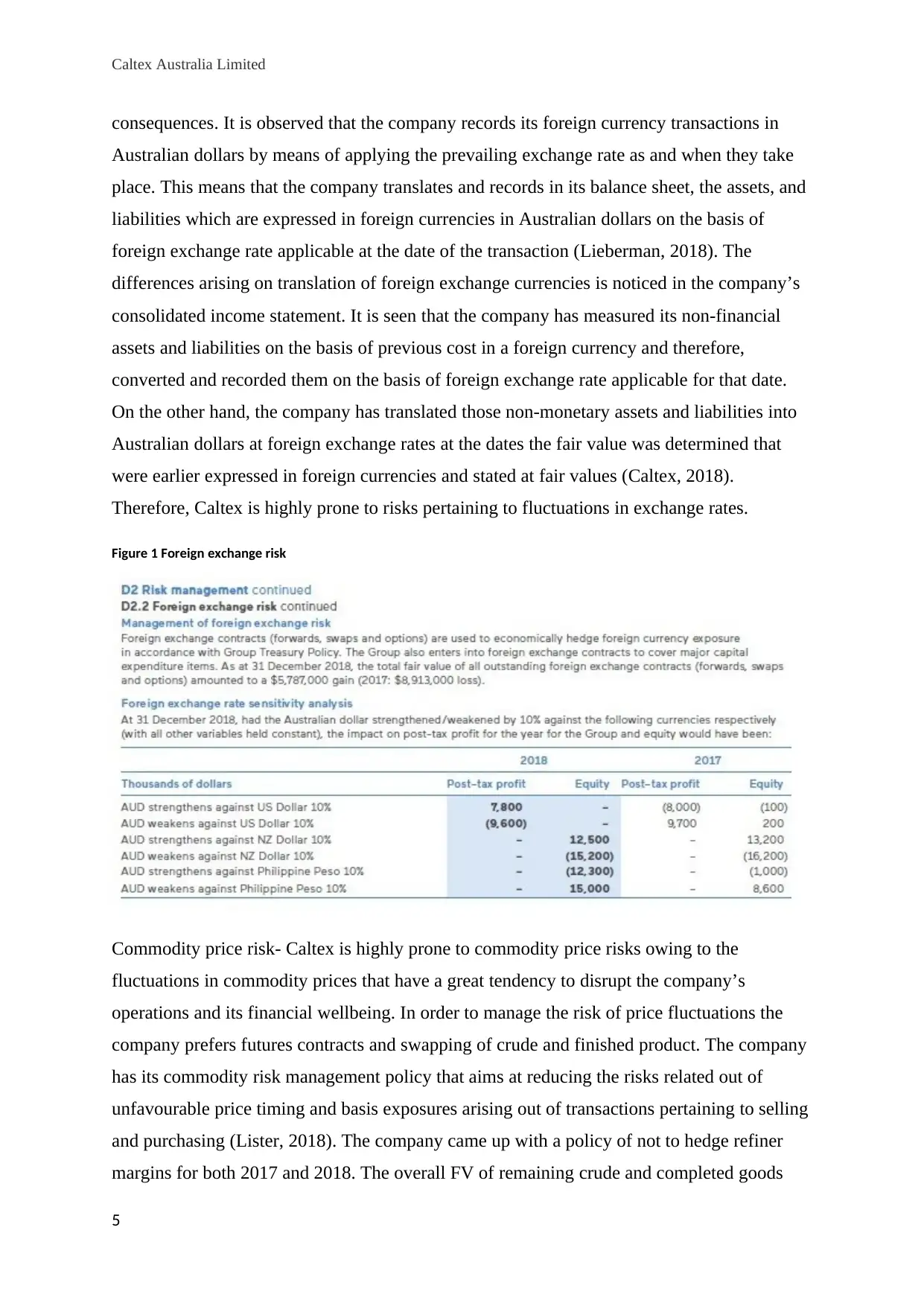
Caltex Australia Limited
consequences. It is observed that the company records its foreign currency transactions in
Australian dollars by means of applying the prevailing exchange rate as and when they take
place. This means that the company translates and records in its balance sheet, the assets, and
liabilities which are expressed in foreign currencies in Australian dollars on the basis of
foreign exchange rate applicable at the date of the transaction (Lieberman, 2018). The
differences arising on translation of foreign exchange currencies is noticed in the company’s
consolidated income statement. It is seen that the company has measured its non-financial
assets and liabilities on the basis of previous cost in a foreign currency and therefore,
converted and recorded them on the basis of foreign exchange rate applicable for that date.
On the other hand, the company has translated those non-monetary assets and liabilities into
Australian dollars at foreign exchange rates at the dates the fair value was determined that
were earlier expressed in foreign currencies and stated at fair values (Caltex, 2018).
Therefore, Caltex is highly prone to risks pertaining to fluctuations in exchange rates.
Figure 1 Foreign exchange risk
Commodity price risk- Caltex is highly prone to commodity price risks owing to the
fluctuations in commodity prices that have a great tendency to disrupt the company’s
operations and its financial wellbeing. In order to manage the risk of price fluctuations the
company prefers futures contracts and swapping of crude and finished product. The company
has its commodity risk management policy that aims at reducing the risks related out of
unfavourable price timing and basis exposures arising out of transactions pertaining to selling
and purchasing (Lister, 2018). The company came up with a policy of not to hedge refiner
margins for both 2017 and 2018. The overall FV of remaining crude and completed goods
5
consequences. It is observed that the company records its foreign currency transactions in
Australian dollars by means of applying the prevailing exchange rate as and when they take
place. This means that the company translates and records in its balance sheet, the assets, and
liabilities which are expressed in foreign currencies in Australian dollars on the basis of
foreign exchange rate applicable at the date of the transaction (Lieberman, 2018). The
differences arising on translation of foreign exchange currencies is noticed in the company’s
consolidated income statement. It is seen that the company has measured its non-financial
assets and liabilities on the basis of previous cost in a foreign currency and therefore,
converted and recorded them on the basis of foreign exchange rate applicable for that date.
On the other hand, the company has translated those non-monetary assets and liabilities into
Australian dollars at foreign exchange rates at the dates the fair value was determined that
were earlier expressed in foreign currencies and stated at fair values (Caltex, 2018).
Therefore, Caltex is highly prone to risks pertaining to fluctuations in exchange rates.
Figure 1 Foreign exchange risk
Commodity price risk- Caltex is highly prone to commodity price risks owing to the
fluctuations in commodity prices that have a great tendency to disrupt the company’s
operations and its financial wellbeing. In order to manage the risk of price fluctuations the
company prefers futures contracts and swapping of crude and finished product. The company
has its commodity risk management policy that aims at reducing the risks related out of
unfavourable price timing and basis exposures arising out of transactions pertaining to selling
and purchasing (Lister, 2018). The company came up with a policy of not to hedge refiner
margins for both 2017 and 2018. The overall FV of remaining crude and completed goods
5
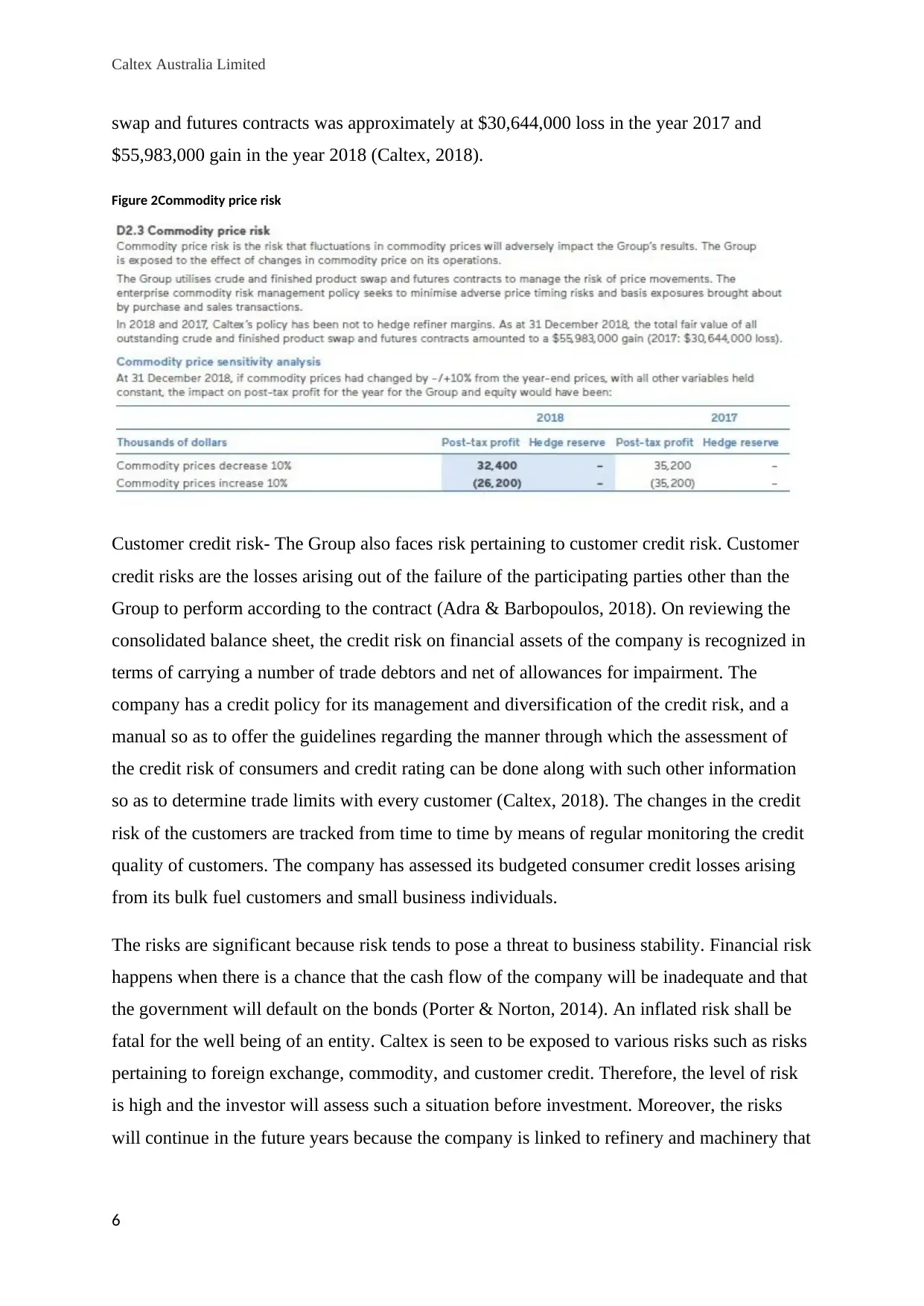
Caltex Australia Limited
swap and futures contracts was approximately at $30,644,000 loss in the year 2017 and
$55,983,000 gain in the year 2018 (Caltex, 2018).
Figure 2Commodity price risk
Customer credit risk- The Group also faces risk pertaining to customer credit risk. Customer
credit risks are the losses arising out of the failure of the participating parties other than the
Group to perform according to the contract (Adra & Barbopoulos, 2018). On reviewing the
consolidated balance sheet, the credit risk on financial assets of the company is recognized in
terms of carrying a number of trade debtors and net of allowances for impairment. The
company has a credit policy for its management and diversification of the credit risk, and a
manual so as to offer the guidelines regarding the manner through which the assessment of
the credit risk of consumers and credit rating can be done along with such other information
so as to determine trade limits with every customer (Caltex, 2018). The changes in the credit
risk of the customers are tracked from time to time by means of regular monitoring the credit
quality of customers. The company has assessed its budgeted consumer credit losses arising
from its bulk fuel customers and small business individuals.
The risks are significant because risk tends to pose a threat to business stability. Financial risk
happens when there is a chance that the cash flow of the company will be inadequate and that
the government will default on the bonds (Porter & Norton, 2014). An inflated risk shall be
fatal for the well being of an entity. Caltex is seen to be exposed to various risks such as risks
pertaining to foreign exchange, commodity, and customer credit. Therefore, the level of risk
is high and the investor will assess such a situation before investment. Moreover, the risks
will continue in the future years because the company is linked to refinery and machinery that
6
swap and futures contracts was approximately at $30,644,000 loss in the year 2017 and
$55,983,000 gain in the year 2018 (Caltex, 2018).
Figure 2Commodity price risk
Customer credit risk- The Group also faces risk pertaining to customer credit risk. Customer
credit risks are the losses arising out of the failure of the participating parties other than the
Group to perform according to the contract (Adra & Barbopoulos, 2018). On reviewing the
consolidated balance sheet, the credit risk on financial assets of the company is recognized in
terms of carrying a number of trade debtors and net of allowances for impairment. The
company has a credit policy for its management and diversification of the credit risk, and a
manual so as to offer the guidelines regarding the manner through which the assessment of
the credit risk of consumers and credit rating can be done along with such other information
so as to determine trade limits with every customer (Caltex, 2018). The changes in the credit
risk of the customers are tracked from time to time by means of regular monitoring the credit
quality of customers. The company has assessed its budgeted consumer credit losses arising
from its bulk fuel customers and small business individuals.
The risks are significant because risk tends to pose a threat to business stability. Financial risk
happens when there is a chance that the cash flow of the company will be inadequate and that
the government will default on the bonds (Porter & Norton, 2014). An inflated risk shall be
fatal for the well being of an entity. Caltex is seen to be exposed to various risks such as risks
pertaining to foreign exchange, commodity, and customer credit. Therefore, the level of risk
is high and the investor will assess such a situation before investment. Moreover, the risks
will continue in the future years because the company is linked to refinery and machinery that
6
⊘ This is a preview!⊘
Do you want full access?
Subscribe today to unlock all pages.

Trusted by 1+ million students worldwide
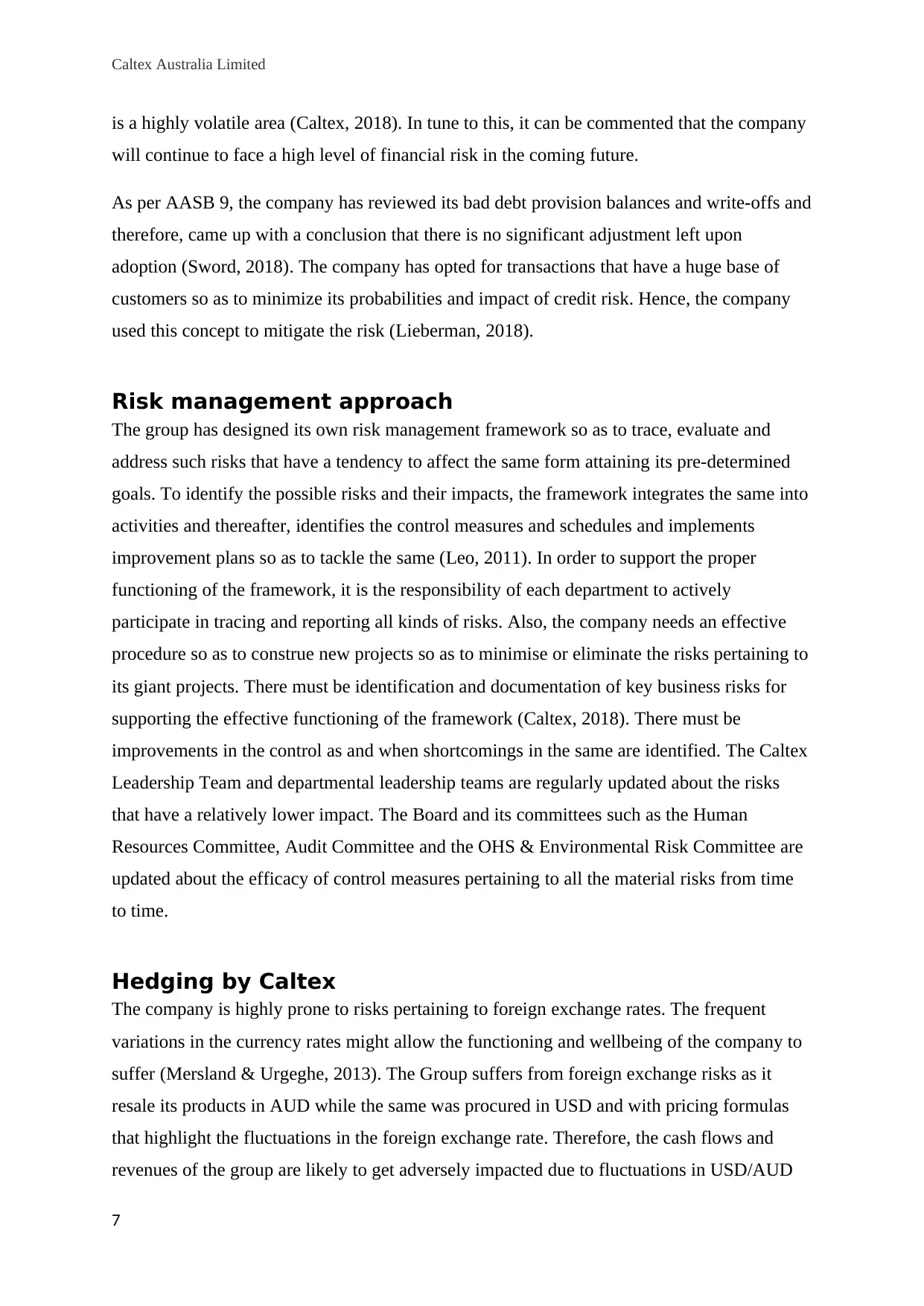
Caltex Australia Limited
is a highly volatile area (Caltex, 2018). In tune to this, it can be commented that the company
will continue to face a high level of financial risk in the coming future.
As per AASB 9, the company has reviewed its bad debt provision balances and write-offs and
therefore, came up with a conclusion that there is no significant adjustment left upon
adoption (Sword, 2018). The company has opted for transactions that have a huge base of
customers so as to minimize its probabilities and impact of credit risk. Hence, the company
used this concept to mitigate the risk (Lieberman, 2018).
Risk management approach
The group has designed its own risk management framework so as to trace, evaluate and
address such risks that have a tendency to affect the same form attaining its pre-determined
goals. To identify the possible risks and their impacts, the framework integrates the same into
activities and thereafter, identifies the control measures and schedules and implements
improvement plans so as to tackle the same (Leo, 2011). In order to support the proper
functioning of the framework, it is the responsibility of each department to actively
participate in tracing and reporting all kinds of risks. Also, the company needs an effective
procedure so as to construe new projects so as to minimise or eliminate the risks pertaining to
its giant projects. There must be identification and documentation of key business risks for
supporting the effective functioning of the framework (Caltex, 2018). There must be
improvements in the control as and when shortcomings in the same are identified. The Caltex
Leadership Team and departmental leadership teams are regularly updated about the risks
that have a relatively lower impact. The Board and its committees such as the Human
Resources Committee, Audit Committee and the OHS & Environmental Risk Committee are
updated about the efficacy of control measures pertaining to all the material risks from time
to time.
Hedging by Caltex
The company is highly prone to risks pertaining to foreign exchange rates. The frequent
variations in the currency rates might allow the functioning and wellbeing of the company to
suffer (Mersland & Urgeghe, 2013). The Group suffers from foreign exchange risks as it
resale its products in AUD while the same was procured in USD and with pricing formulas
that highlight the fluctuations in the foreign exchange rate. Therefore, the cash flows and
revenues of the group are likely to get adversely impacted due to fluctuations in USD/AUD
7
is a highly volatile area (Caltex, 2018). In tune to this, it can be commented that the company
will continue to face a high level of financial risk in the coming future.
As per AASB 9, the company has reviewed its bad debt provision balances and write-offs and
therefore, came up with a conclusion that there is no significant adjustment left upon
adoption (Sword, 2018). The company has opted for transactions that have a huge base of
customers so as to minimize its probabilities and impact of credit risk. Hence, the company
used this concept to mitigate the risk (Lieberman, 2018).
Risk management approach
The group has designed its own risk management framework so as to trace, evaluate and
address such risks that have a tendency to affect the same form attaining its pre-determined
goals. To identify the possible risks and their impacts, the framework integrates the same into
activities and thereafter, identifies the control measures and schedules and implements
improvement plans so as to tackle the same (Leo, 2011). In order to support the proper
functioning of the framework, it is the responsibility of each department to actively
participate in tracing and reporting all kinds of risks. Also, the company needs an effective
procedure so as to construe new projects so as to minimise or eliminate the risks pertaining to
its giant projects. There must be identification and documentation of key business risks for
supporting the effective functioning of the framework (Caltex, 2018). There must be
improvements in the control as and when shortcomings in the same are identified. The Caltex
Leadership Team and departmental leadership teams are regularly updated about the risks
that have a relatively lower impact. The Board and its committees such as the Human
Resources Committee, Audit Committee and the OHS & Environmental Risk Committee are
updated about the efficacy of control measures pertaining to all the material risks from time
to time.
Hedging by Caltex
The company is highly prone to risks pertaining to foreign exchange rates. The frequent
variations in the currency rates might allow the functioning and wellbeing of the company to
suffer (Mersland & Urgeghe, 2013). The Group suffers from foreign exchange risks as it
resale its products in AUD while the same was procured in USD and with pricing formulas
that highlight the fluctuations in the foreign exchange rate. Therefore, the cash flows and
revenues of the group are likely to get adversely impacted due to fluctuations in USD/AUD
7
Paraphrase This Document
Need a fresh take? Get an instant paraphrase of this document with our AI Paraphraser
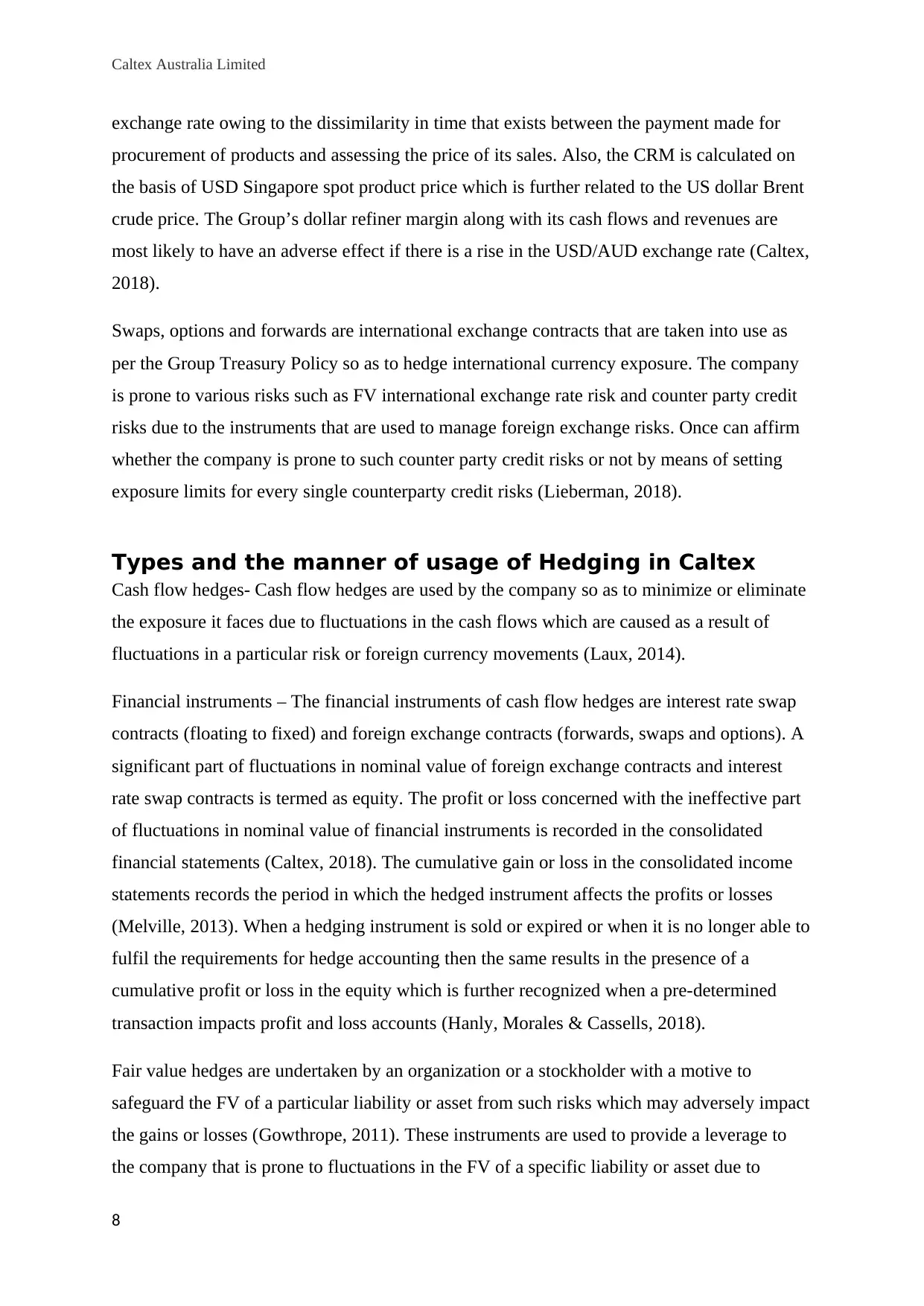
Caltex Australia Limited
exchange rate owing to the dissimilarity in time that exists between the payment made for
procurement of products and assessing the price of its sales. Also, the CRM is calculated on
the basis of USD Singapore spot product price which is further related to the US dollar Brent
crude price. The Group’s dollar refiner margin along with its cash flows and revenues are
most likely to have an adverse effect if there is a rise in the USD/AUD exchange rate (Caltex,
2018).
Swaps, options and forwards are international exchange contracts that are taken into use as
per the Group Treasury Policy so as to hedge international currency exposure. The company
is prone to various risks such as FV international exchange rate risk and counter party credit
risks due to the instruments that are used to manage foreign exchange risks. Once can affirm
whether the company is prone to such counter party credit risks or not by means of setting
exposure limits for every single counterparty credit risks (Lieberman, 2018).
Types and the manner of usage of Hedging in Caltex
Cash flow hedges- Cash flow hedges are used by the company so as to minimize or eliminate
the exposure it faces due to fluctuations in the cash flows which are caused as a result of
fluctuations in a particular risk or foreign currency movements (Laux, 2014).
Financial instruments – The financial instruments of cash flow hedges are interest rate swap
contracts (floating to fixed) and foreign exchange contracts (forwards, swaps and options). A
significant part of fluctuations in nominal value of foreign exchange contracts and interest
rate swap contracts is termed as equity. The profit or loss concerned with the ineffective part
of fluctuations in nominal value of financial instruments is recorded in the consolidated
financial statements (Caltex, 2018). The cumulative gain or loss in the consolidated income
statements records the period in which the hedged instrument affects the profits or losses
(Melville, 2013). When a hedging instrument is sold or expired or when it is no longer able to
fulfil the requirements for hedge accounting then the same results in the presence of a
cumulative profit or loss in the equity which is further recognized when a pre-determined
transaction impacts profit and loss accounts (Hanly, Morales & Cassells, 2018).
Fair value hedges are undertaken by an organization or a stockholder with a motive to
safeguard the FV of a particular liability or asset from such risks which may adversely impact
the gains or losses (Gowthrope, 2011). These instruments are used to provide a leverage to
the company that is prone to fluctuations in the FV of a specific liability or asset due to
8
exchange rate owing to the dissimilarity in time that exists between the payment made for
procurement of products and assessing the price of its sales. Also, the CRM is calculated on
the basis of USD Singapore spot product price which is further related to the US dollar Brent
crude price. The Group’s dollar refiner margin along with its cash flows and revenues are
most likely to have an adverse effect if there is a rise in the USD/AUD exchange rate (Caltex,
2018).
Swaps, options and forwards are international exchange contracts that are taken into use as
per the Group Treasury Policy so as to hedge international currency exposure. The company
is prone to various risks such as FV international exchange rate risk and counter party credit
risks due to the instruments that are used to manage foreign exchange risks. Once can affirm
whether the company is prone to such counter party credit risks or not by means of setting
exposure limits for every single counterparty credit risks (Lieberman, 2018).
Types and the manner of usage of Hedging in Caltex
Cash flow hedges- Cash flow hedges are used by the company so as to minimize or eliminate
the exposure it faces due to fluctuations in the cash flows which are caused as a result of
fluctuations in a particular risk or foreign currency movements (Laux, 2014).
Financial instruments – The financial instruments of cash flow hedges are interest rate swap
contracts (floating to fixed) and foreign exchange contracts (forwards, swaps and options). A
significant part of fluctuations in nominal value of foreign exchange contracts and interest
rate swap contracts is termed as equity. The profit or loss concerned with the ineffective part
of fluctuations in nominal value of financial instruments is recorded in the consolidated
financial statements (Caltex, 2018). The cumulative gain or loss in the consolidated income
statements records the period in which the hedged instrument affects the profits or losses
(Melville, 2013). When a hedging instrument is sold or expired or when it is no longer able to
fulfil the requirements for hedge accounting then the same results in the presence of a
cumulative profit or loss in the equity which is further recognized when a pre-determined
transaction impacts profit and loss accounts (Hanly, Morales & Cassells, 2018).
Fair value hedges are undertaken by an organization or a stockholder with a motive to
safeguard the FV of a particular liability or asset from such risks which may adversely impact
the gains or losses (Gowthrope, 2011). These instruments are used to provide a leverage to
the company that is prone to fluctuations in the FV of a specific liability or asset due to
8

Caltex Australia Limited
constant fluctuations in interest rates. The financial instrument used in fair value hedge is
interest rate swap contracts (fixed-to-floating).
The consolidated income statement of the company records the FV hedges along with the
fluctuations in the FV of a specific liability or assets from such risks which may negatively
impact the profits or losses (Caltex, 2018).
Net investment hedges are used in order to minimize or eliminate risks arising out of a
company’s net investment in an international activity. The instrument used in net investment
hedges is foreign currency borrowings (Caltex, 2018). Net investment hedges are treated by
means of recording the same in the consolidated income statement as and when the
completion of an international activity takes place.
9
constant fluctuations in interest rates. The financial instrument used in fair value hedge is
interest rate swap contracts (fixed-to-floating).
The consolidated income statement of the company records the FV hedges along with the
fluctuations in the FV of a specific liability or assets from such risks which may negatively
impact the profits or losses (Caltex, 2018).
Net investment hedges are used in order to minimize or eliminate risks arising out of a
company’s net investment in an international activity. The instrument used in net investment
hedges is foreign currency borrowings (Caltex, 2018). Net investment hedges are treated by
means of recording the same in the consolidated income statement as and when the
completion of an international activity takes place.
9
⊘ This is a preview!⊘
Do you want full access?
Subscribe today to unlock all pages.

Trusted by 1+ million students worldwide
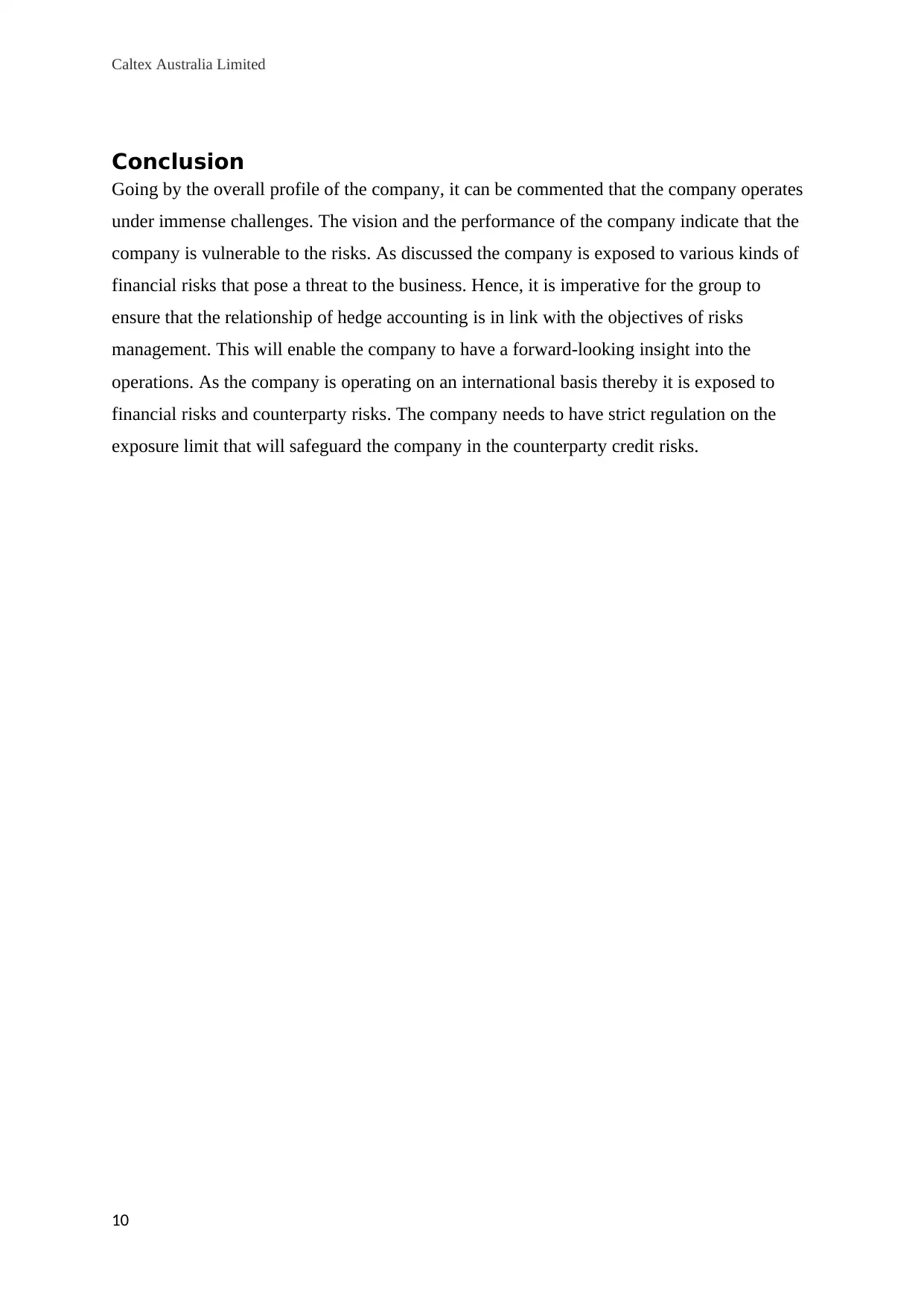
Caltex Australia Limited
Conclusion
Going by the overall profile of the company, it can be commented that the company operates
under immense challenges. The vision and the performance of the company indicate that the
company is vulnerable to the risks. As discussed the company is exposed to various kinds of
financial risks that pose a threat to the business. Hence, it is imperative for the group to
ensure that the relationship of hedge accounting is in link with the objectives of risks
management. This will enable the company to have a forward-looking insight into the
operations. As the company is operating on an international basis thereby it is exposed to
financial risks and counterparty risks. The company needs to have strict regulation on the
exposure limit that will safeguard the company in the counterparty credit risks.
10
Conclusion
Going by the overall profile of the company, it can be commented that the company operates
under immense challenges. The vision and the performance of the company indicate that the
company is vulnerable to the risks. As discussed the company is exposed to various kinds of
financial risks that pose a threat to the business. Hence, it is imperative for the group to
ensure that the relationship of hedge accounting is in link with the objectives of risks
management. This will enable the company to have a forward-looking insight into the
operations. As the company is operating on an international basis thereby it is exposed to
financial risks and counterparty risks. The company needs to have strict regulation on the
exposure limit that will safeguard the company in the counterparty credit risks.
10
Paraphrase This Document
Need a fresh take? Get an instant paraphrase of this document with our AI Paraphraser
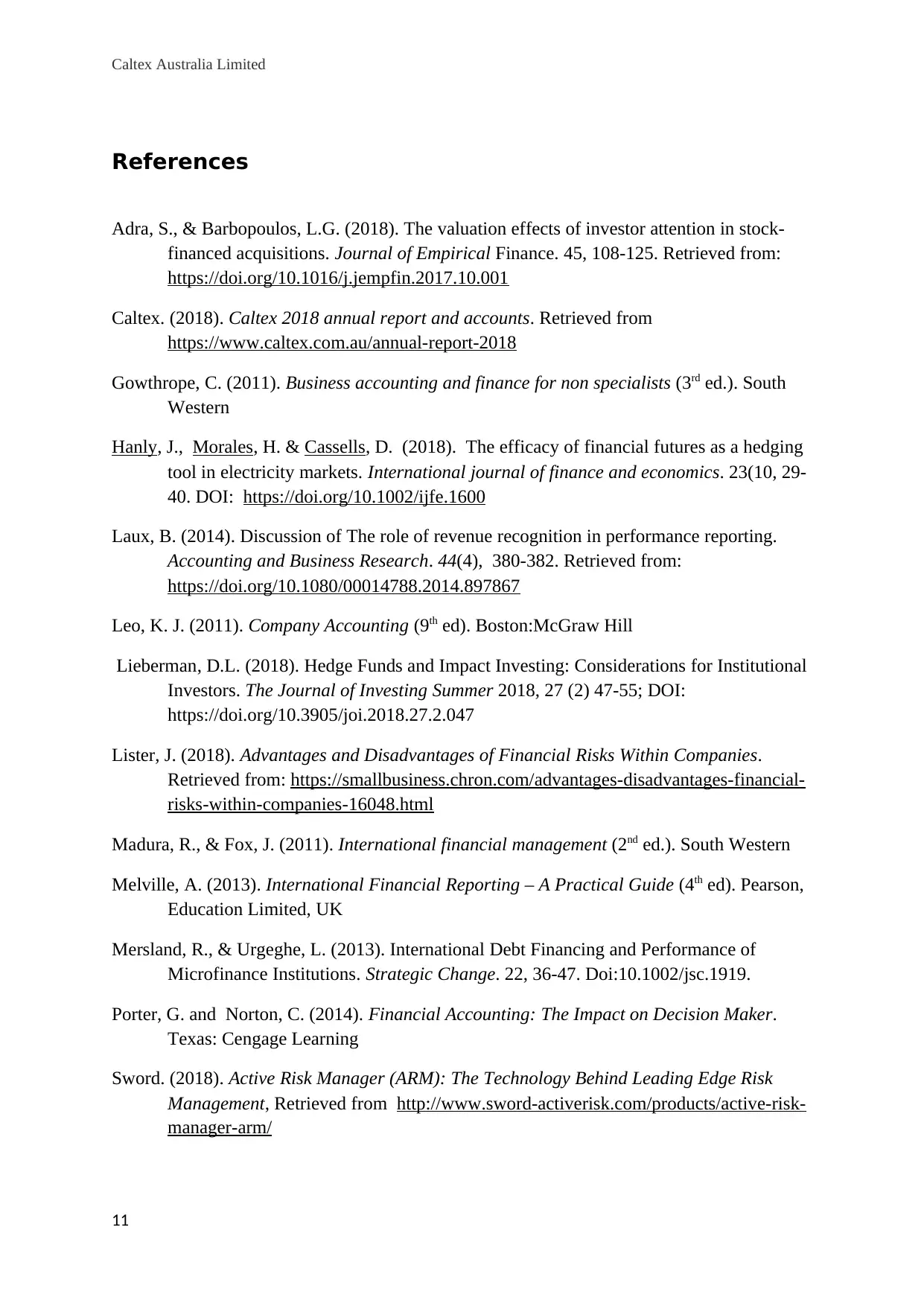
Caltex Australia Limited
References
Adra, S., & Barbopoulos, L.G. (2018). The valuation effects of investor attention in stock-
financed acquisitions. Journal of Empirical Finance. 45, 108-125. Retrieved from:
https://doi.org/10.1016/j.jempfin.2017.10.001
Caltex. (2018). Caltex 2018 annual report and accounts. Retrieved from
https://www.caltex.com.au/annual-report-2018
Gowthrope, C. (2011). Business accounting and finance for non specialists (3rd ed.). South
Western
Hanly, J., Morales, H. & Cassells, D. (2018). The efficacy of financial futures as a hedging
tool in electricity markets. International journal of finance and economics. 23(10, 29-
40. DOI: https://doi.org/10.1002/ijfe.1600
Laux, B. (2014). Discussion of The role of revenue recognition in performance reporting.
Accounting and Business Research. 44(4), 380-382. Retrieved from:
https://doi.org/10.1080/00014788.2014.897867
Leo, K. J. (2011). Company Accounting (9th ed). Boston:McGraw Hill
Lieberman, D.L. (2018). Hedge Funds and Impact Investing: Considerations for Institutional
Investors. The Journal of Investing Summer 2018, 27 (2) 47-55; DOI:
https://doi.org/10.3905/joi.2018.27.2.047
Lister, J. (2018). Advantages and Disadvantages of Financial Risks Within Companies.
Retrieved from: https://smallbusiness.chron.com/advantages-disadvantages-financial-
risks-within-companies-16048.html
Madura, R., & Fox, J. (2011). International financial management (2nd ed.). South Western
Melville, A. (2013). International Financial Reporting – A Practical Guide (4th ed). Pearson,
Education Limited, UK
Mersland, R., & Urgeghe, L. (2013). International Debt Financing and Performance of
Microfinance Institutions. Strategic Change. 22, 36-47. Doi:10.1002/jsc.1919.
Porter, G. and Norton, C. (2014). Financial Accounting: The Impact on Decision Maker.
Texas: Cengage Learning
Sword. (2018). Active Risk Manager (ARM): The Technology Behind Leading Edge Risk
Management, Retrieved from http://www.sword-activerisk.com/products/active-risk-
manager-arm/
11
References
Adra, S., & Barbopoulos, L.G. (2018). The valuation effects of investor attention in stock-
financed acquisitions. Journal of Empirical Finance. 45, 108-125. Retrieved from:
https://doi.org/10.1016/j.jempfin.2017.10.001
Caltex. (2018). Caltex 2018 annual report and accounts. Retrieved from
https://www.caltex.com.au/annual-report-2018
Gowthrope, C. (2011). Business accounting and finance for non specialists (3rd ed.). South
Western
Hanly, J., Morales, H. & Cassells, D. (2018). The efficacy of financial futures as a hedging
tool in electricity markets. International journal of finance and economics. 23(10, 29-
40. DOI: https://doi.org/10.1002/ijfe.1600
Laux, B. (2014). Discussion of The role of revenue recognition in performance reporting.
Accounting and Business Research. 44(4), 380-382. Retrieved from:
https://doi.org/10.1080/00014788.2014.897867
Leo, K. J. (2011). Company Accounting (9th ed). Boston:McGraw Hill
Lieberman, D.L. (2018). Hedge Funds and Impact Investing: Considerations for Institutional
Investors. The Journal of Investing Summer 2018, 27 (2) 47-55; DOI:
https://doi.org/10.3905/joi.2018.27.2.047
Lister, J. (2018). Advantages and Disadvantages of Financial Risks Within Companies.
Retrieved from: https://smallbusiness.chron.com/advantages-disadvantages-financial-
risks-within-companies-16048.html
Madura, R., & Fox, J. (2011). International financial management (2nd ed.). South Western
Melville, A. (2013). International Financial Reporting – A Practical Guide (4th ed). Pearson,
Education Limited, UK
Mersland, R., & Urgeghe, L. (2013). International Debt Financing and Performance of
Microfinance Institutions. Strategic Change. 22, 36-47. Doi:10.1002/jsc.1919.
Porter, G. and Norton, C. (2014). Financial Accounting: The Impact on Decision Maker.
Texas: Cengage Learning
Sword. (2018). Active Risk Manager (ARM): The Technology Behind Leading Edge Risk
Management, Retrieved from http://www.sword-activerisk.com/products/active-risk-
manager-arm/
11
1 out of 11
Related Documents
Your All-in-One AI-Powered Toolkit for Academic Success.
+13062052269
info@desklib.com
Available 24*7 on WhatsApp / Email
![[object Object]](/_next/static/media/star-bottom.7253800d.svg)
Unlock your academic potential
Copyright © 2020–2026 A2Z Services. All Rights Reserved. Developed and managed by ZUCOL.





